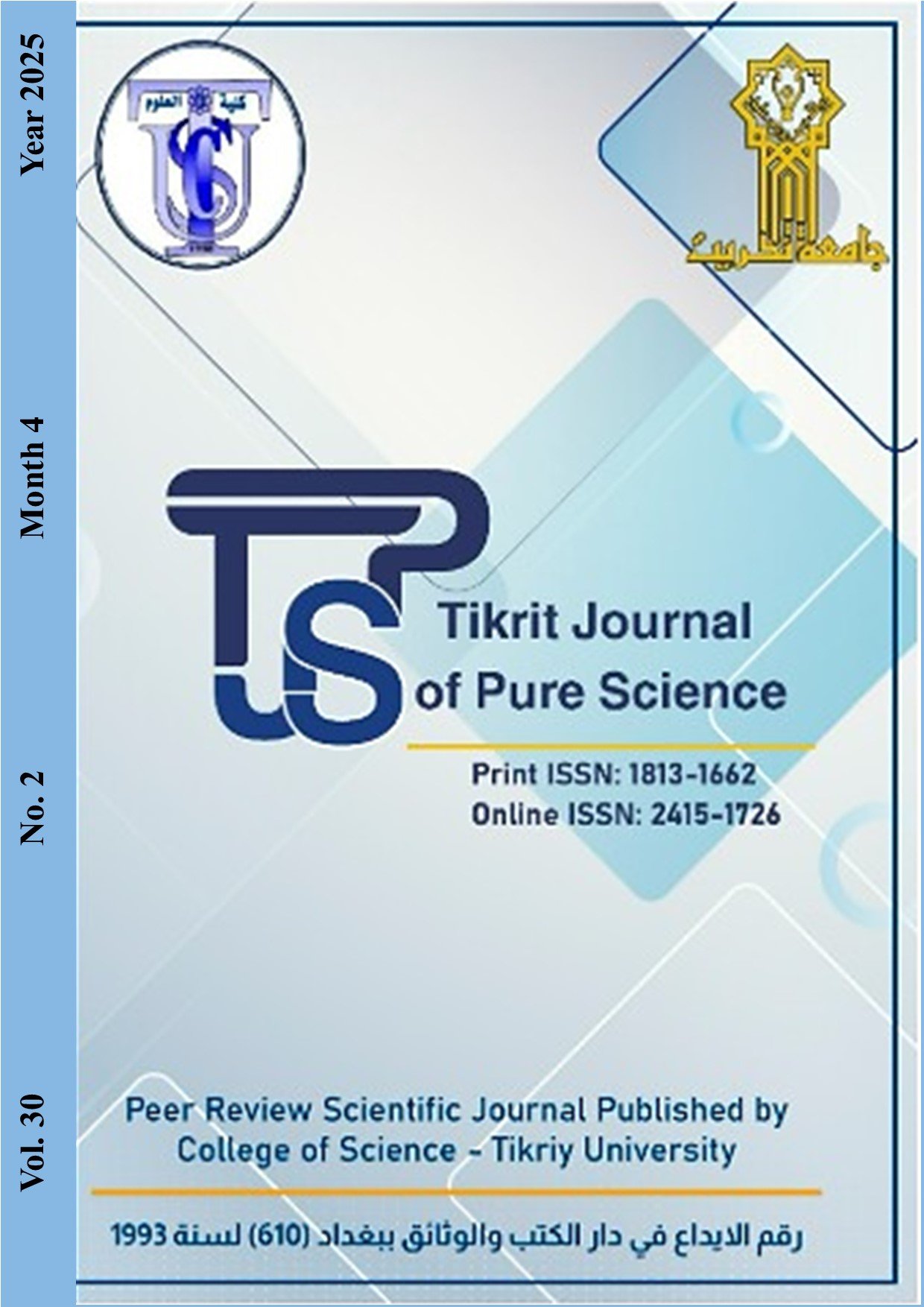Seasonal Taxonomic Study of Attached Cyanophyceae Algae on Biological Treatment Pond Within Dura Refinery / Baghdad
Main Article Content
Abstract
A seasonal taxonomic study was conducted of Attached Cyanophyceae algae on biological treatment pond in Dura refinery at Baghdad city for three seasons (Summer, Autum 2020, Winter 2021). The current study recorded (41 species) belonging to (13 Genus) of attached Cyanophyceae algae, including three Orders: Oscillatoriales were the dominant group (4genus, 16 species), followed by Chroococcales (5 genus, 15 species), and Nostocales (4 genus, 10 species). Cyanophyceae are characterized by ability to live, grow and reproduce in a wide range of environmental changes and pollution levels especially industrial waste. Cyanophyceae can be revived in the pond as it has the ability to break down petroleum and organic compounds.
Article Details

This work is licensed under a Creative Commons Attribution 4.0 International License.
Tikrit Journal of Pure Science is licensed under the Creative Commons Attribution 4.0 International License, which allows users to copy, create extracts, abstracts, and new works from the article, alter and revise the article, and make commercial use of the article (including reuse and/or resale of the article by commercial entities), provided the user gives appropriate credit (with a link to the formal publication through the relevant DOI), provides a link to the license, indicates if changes were made, and the licensor is not represented as endorsing the use made of the work. The authors hold the copyright for their published work on the Tikrit J. Pure Sci. website, while Tikrit J. Pure Sci. is responsible for appreciate citation of their work, which is released under CC-BY-4.0, enabling the unrestricted use, distribution, and reproduction of an article in any medium, provided that the original work is properly cited.
References
1. Graham E, Graham MJ, Wilcox WL. Algae. USA: Person Benjomin cammons; 2009.
2. Muñoz I, Aktürk AS, Ayyıldız Ö, Çağlar Ö, Meabe E, Contreras S, et al. Life cycle assessment of wastewater reclamation in a petroleum refinery in Turkey. Journal of Cleaner Production. 2020;268:121967. https://doi.org/10.1016/j.jclepro.2020.121967.
3. Al-Sabah BJJ. A study of the physiochemical behavior of colored mineral elements in Shatt al-Arab water and sediments: University of Basra; 2007.
4. Thapa B, Kc AK, Ghimire A. A review on bioremediation of petroleum hydrocarbon contaminants in soil. Kathmandu university journal of science, engineering and technology. 2012;8(1):164-70. https://doi.org/10.3126/kuset.v8i1.6056.
5. Abdel Karim M. US occupation and environmental destruction in Iraq. Baghdad: Hammurabi Center for Research and Strategic Studies; 2013.
6. Fetscher AE, Busse L, Ode PR. Standard operating procedures for collecting stream algae samples and associated physical habitat and chemical data for ambient bioassessments in California. California State Water Resources Control Board Surface Water Ambient Monitoring Program (SWAMP) Bioassessment SOP. 2009;2.
7. Desikachary T V. Indian Council of Agricultural Research. New Delhi1959.
8. Nurul-Islam A. A Preliminary report on the phytoplanktons and other algal flora of Chittagong Hilltracts. Journal of the Asiatic Society of Pakistan. 1969;14(3):343-63.
9. GW P. Algae of the western Great Lakes Area. Iowa, USA: William C Brown Co., Publ. Dubuque; 1982.
10. Nural-Islam A, Haroon AY. Studies on Chaetophoraceae from southern Iraq. Internationale Revue der gesamten Hydrobiologie und Hydrographie. 1983;68(3):443-51.
https://doi.org/10.1002/iroh.19830680316
11. Abdel-Bari RR. Treatment of industrial water pollution contaminated with sulfates in Dora Refinery: University of Baghdad; 2016 10.4236/aim.2013.35060.
12. Lami MH. Toxicity of Al-Dura Oil Refinery Wastes Towards Some Freshwater Phytoplanktons. Engineering and Technology Journal. 2014;32(13 Part (A) Engineering):3185-6.
http://dx.doi.org/10.30684/etj.32.13A.10.
13. Ansari Z, Saldanha M, Rajkumar R. Effects of petroleum hydrocarbons on the growth of a microalga, Isochrysis sp.(Chrysophyta). Indian Journal of Marine Sciences. 1997;26:372-6.
http://drs.nio.org/drs/handle/2264/2009.
14. Aramkitphotha S. A Low Cost Pyrolysis Oil Production From Microalgae. Advances In Natural And Applied Sciences. 2018;12(8):39-43. doi: https://doi.org/10.22587/anas.2018.12.8.8.
15. Zahraw Z, Al-Obaidy A-HMJ, Shakir E, MA S. Algae as bioindicator from pollution of tigris river by industrial wast. Management Research. 2018;5(5):58-64. https://doi.org/10.29121/ijetmr.v5.i5.2018.226.
16. Ahmad A, Banat F, Alsafar H, Hasan SW. Algae biotechnology for industrial wastewater treatment, bioenergy production, and high-value bioproducts. Science of The Total Environment. 2022;806:150585. https://doi.org/10.1016/j.scitotenv.2021.150585.
17. Atlas R, Bragg J. Bioremediation of marine oil spills: when and when not–the Exxon Valdez experience. Microbial biotechnology. 2009;2(2):213-21. https://doi.org/10.1111%2Fj.1751-7915.2008.00079.x.
18. Radice RP, De Fabrizio V, Donadoni A, Scopa A, Martelli G. Crude oil bioremediation: From bacteria to microalgae. Processes. 2023;11(2):442. https://doi.org/10.3390/pr11020442.
